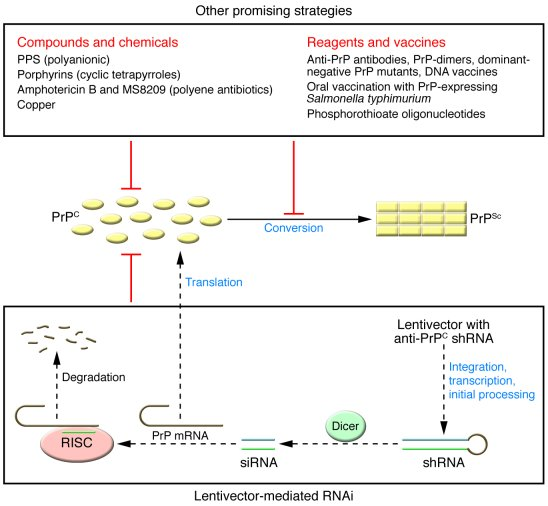The quest for effective prion disease treatment has gained significant momentum, illuminating a path toward hope for patients afflicted by these rare yet devastating disorders. Recent groundbreaking research led by a team at the Broad Institute of MIT and Harvard suggests that gene editing for prion disease may be on the horizon, aiming to mitigate the effects of harmful misfolded proteins in the brain. This promising study employs a novel base editing technique that has shown the potential to dramatically reduce prion protein levels in laboratory settings, extending the lifespan of test subjects significantly. Such innovative developments are not only paving the way for future clinical trials but also revitalizing fatal familial insomnia research, highlighting a pivotal moment in prion disease breakthrough. As researchers delve deeper into gene therapy for prion diseases, the scientific community holds its breath, hoping to turn these advancements into tangible treatments for those suffering from these fatal conditions.
The landscape of prion disorders encompasses a variety of catastrophic neurodegenerative diseases, prominently including Creutzfeldt-Jakob disease and fatal familial insomnia, which arise from the pathological misfolding of proteins. Notably, the progress towards effective treatments for these diseases has gained traction through advanced techniques such as gene editing and gene therapy. Researchers are exploring innovative approaches to alter genetic material to address the underlying causes of these disorders, providing a glimmer of hope in the otherwise grim prognosis associated with prion diseases. As the scientific community mobilizes around this challenge, the collaborative efforts invested in prion disease research are yielding promising results that may soon translate into therapeutic interventions. By unlocking the mysteries of prion pathology, scientists aim to transform the narrative of these fatal conditions, steering toward potential cures.
Breakthroughs in Prion Disease Treatment Research
Recent advancements in the field of prion disease treatment have sparked a renewed sense of hope among researchers and patients alike. A significant breakthrough highlighted in a study published in Nature Medicine has shown that gene editing can potentially alter the course of fatal prion diseases, which include conditions like Creutzfeldt-Jakob disease and fatal familial insomnia. By targeting a specific base in the genetic coding of prion proteins, scientists were able to reduce the levels of these harmful proteins in laboratory mice, extending their lifespans significantly. This promising research underscores the potential of gene therapy and its implications for human health, heralding a new era in the treatment of these devastating neurological conditions.
The journey towards effective prion disease treatment involves not only innovative scientific breakthroughs but also a personal commitment from researchers. As patient-scientists like Sonia Vallabh and Eric Minikel contribute their lived experiences to the research process, they bring urgency and empathy into the lab. Their work not only aims to understand the genetic mechanics behind prion diseases but also to pave the way for future therapies that could change the lives of many affected individuals.
Frequently Asked Questions
What advancements have been made in prion disease treatment using gene editing?
Recent research led by scientists at the Broad Institute has shown that gene editing can significantly reduce the production of toxic prion proteins in laboratory mice, providing hope for potential prion disease treatments. This breakthrough may lead to human trials down the line, aimed at diseases such as Creutzfeldt-Jakob disease, fatal familial insomnia, and Gerstmann-Sträussler-Scheinker disease.
How does gene therapy impact treatment options for prion diseases?
Gene therapy, particularly through techniques like base editing, has the potential to alter the genes responsible for producing harmful prion proteins. This innovative approach is being researched as a viable treatment option for various prion diseases, which are currently incurable.
Are there any recent breakthroughs in fatal familial insomnia research?
Yes, the latest research into fatal familial insomnia, a type of prion disease, highlights promising advancements in gene editing that could eventually offer new treatment possibilities. Ongoing studies aim to refine these techniques for potential clinical application.
What does current research on prion diseases indicate about future treatment possibilities?
Current research suggests that with advancements in gene editing technologies, significant progress could be made toward developing effective treatments for prion diseases. This includes targeting the mechanisms that lead to protein misfolding, which are central to these fatal conditions.
What role do patient-scientists play in prion disease treatment research?
Patient-scientists, like Sonia Vallabh and Eric Minikel, bring invaluable personal experience and motivation to prion disease treatment research. Their insights drive innovative approaches, such as gene therapy, and help prioritize research directions that could lead to breakthroughs in treating these devastating conditions.
| Key Point | Details |
|---|---|
| Research Breakthrough | Gene-editing therapy shows promise in reducing prion protein levels by 50% in mice. |
| Significant Lifespan Extension | Treatment led to a 52% increase in mouse lifespan, indicating potential efficacy. |
| Personal Motivation of Researchers | Sonia Vallabh, a researcher, is personally affected by prion disease, providing a strong drive for the work. |
| Nature of Prion Diseases | Includes Creutzfeldt-Jakob disease, Gerstmann-Sträussler-Scheinker disease, and fatal familial insomnia. |
| Future Steps | Further research needed before human trials can be initiated. |
| Collaborative Effort | Involves a collaboration between multiple labs, enhancing the research’s motivation and effectiveness. |
Summary
Prion disease treatment has made significant strides with the development of a promising gene-editing therapy. This breakthrough is particularly personal for the research team, led by Sonia Vallabh, who has her own connection to the disease. The encouraging results from laboratory mice suggest that we may soon advance toward human trials, which would bring hope to those affected by these rare and fatal conditions. The ongoing collaborative efforts in prion disease research aim to fully realize a viable treatment pathway, offering optimism for patients and families facing these devastating disorders.

